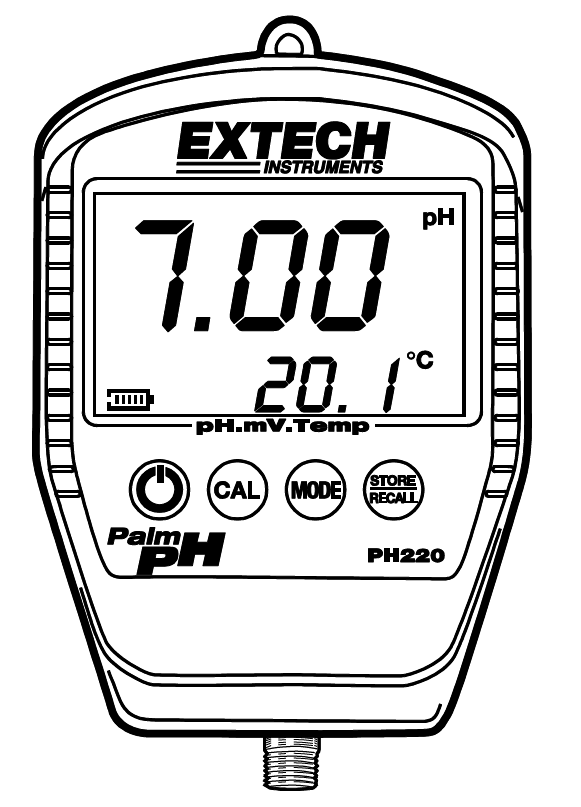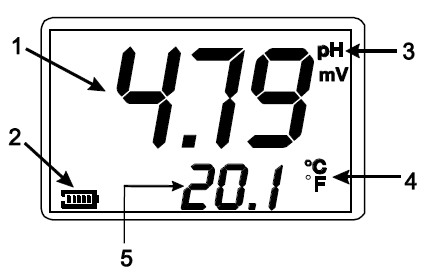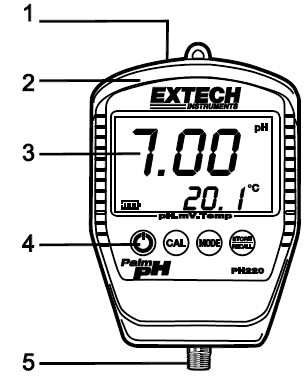Waterproof Palm pH Meter

Introduction
Congratulations on your purchase of the Extech PH220 waterproof pH/mV meter. This microprocessor-based device with tactile push-buttons is battery operated and ideal for field use. The PH220 simultaneously displays pH and temperature. The rubber holster which protects the meter has a magnetic backing for convenient mounting. The built-in memory (25 readings) allows STORE, RECALL, and CLEAR functionality. Careful use of this meter will provide years of reliable service.
Specifications
| Range (Resolution) | Accuracy | |
| Temperature | 32 to 194oF (0.1°<100o; 1 o >100o)
0 to 90oC (0.1°) |
± 1.8oF
± 1.0oC |
| pH |
0.00 to 14.00pH (0.01pH) |
± 0.02pH |
|
-1999mV to 1999mV |
± 2mV |
|
| Note 1: Accuracy does not include pH buffer temperature coefficient
Note 2: Accuracy specified from 0.02pH to 13.98pH |
||
| Temperature Compensation | 32 to 194oF (0 to 90oC) Automatic ‘ATC’ | |
| Power | 9 volt alkaline battery | |
| Display | Dual LCD display for simultaneous pH and temperature readings | |
| Over-range or open indication | Displays “HHH” for over-range or open input conditions
Displays “LLL” for under-range |
|
| pH Calibration points | 4.00, 7.00, 10.00 (1, 2, or 3 point calibration can be performed) | |
| Auto Power OFF | 10 minutes from last key-press (can be disabled) | |
| Low Battery Indication | Fill bars in the battery display icon represent battery power status. The fewer the bars, the weaker the
battery power. |
|
| Dimensions / Weight | 4.25 x 3.00 x 1.18″ (108 x 75 x 30mm) / 4.8 oz. (135g) | |
| Accessories supplied with kit | Battery, suction cup holder, clip holder, stick electrode for model PH220-S, standard electrode with 39” cable for model PH220-C. |
Meter Description
- Battery Compartment (under holster)
- Rubber Holster
- LCD Display
- Function buttons
- Electrode input
Basic Display Description

- Measurement value
- Battery status
- Units of measure
- Temperature units
- Solution temperature
Note that there are other more specialized displays discussed later in the appropriate sections of this manual.
Order of Operations
- Calibrate the instrument as described in the Calibration section.
- Select the temperature units of measure as explained in the pH measurement instructions.
- Carefully follow all step by step instructions and electrode cleaning/rinsing recommendations. Slight deviations in procedures can significantly affect test results.
Calibration (pH)
The sensitivity of a pH electrode degrades over time, it is important to frequently calibrate the meter to the electrode. pH electrodes can be thought of as batteries in that they run down with time and use.
Calibration is performed using standard buffer solutions at room temperature (78°F [25°C]). Buffers are solutions of a known pH that have the useful property of resisting changes in pH. These can be purchased pre-mixed or in capsule form and are usually available in three pH values, pH 4.00, pH 7.00 and pH 10.00.Calibration is always performed using the pH 7.00 buffer first, followed by a second calibration. Select pH 4 buffer for the second calibration if typical measurements will be less than pH7 or use a pH 10 buffer if typical measurements will be greater than pH7.
In order to obtain the most accurate results possible, a pH meter should be calibrated at least once each day.
pH Calibration Procedure
- Place the electrode into a 7.00 pH buffer solution. Press and hold the CAL button until ‘CAL’ appears in the display.
- The instrument automatically recognizes the solution and calibrates to that value. Note that if the solution is inaccurate by more than 1 pH from the 4, 7, or 10 pH buffer, or if the electrode slope is low, the instrument will assume an error and abort the calibration (‘End’ will be displayed).
- During calibration, the pH reading flashes on the main display.
- When calibration is complete, the instrument displays ‘SA’ followed by ‘End’ and then returns to the normal operation mode.
- For a 2- or 3-point calibration, repeat steps 1 ~ 4. When performing a 2- or 3-point calibration, calibrate with pH 7 buffer first, then follow with pH 4 and/or pH 10.
‘CAL’ Reminder Display
When in pH measurement mode, the ‘CAL’ icon will appear if a calibration has not been performed after 15 ON/OFF cycles of the instrument. The ‘CAL’ display is a only a reminder and will turn off when the electrode is calibrated (the reminder does not affect operation).
Measuring pH
NOTE: Electrodes should always be rinsed before and between samples with distilled or DI (de-ionized) water to remove all traces of storage solution, process media, or previous test solution.
- Connect the pH electrode to the meter.
- Turn the meter ON using the ON/OFF button . Wait for the self-test to finish.
- Use the MODE button to select pH mode. The unit of measure appears on the LCD.
- To change the unit of measure for temperature, press and hold the MODE button for 2 seconds. The LCD reflects the current unit of measure.
- Rinse the electrode with distilled or deionized water.
- Place the electrode in the solution. Allow 30 seconds for the electrode/ATC to reach thermal equilibrium with the buffer solution.
- After the measurement stabilizes, view the pH reading on the main display. An out of range reading is indicated by the display icon “HHH”.Note that “HHH” will also display when the electrode is disconnected.
- When the test is complete rinse the electrode with distilled or deionized water.
Automatic Temperature Compensation (ATC)
The millivolt output of a pH electrode varies with temperature, and so the meter must compensate for these variations. The PH220 automatically compensates for solutiontemperature changes with the electrode’s built-in thermometer. The temperature compensation is active when the solution temperature deviates from room temperature. The temperature of a solution is displayed on the lower LCD line.
Automatic Power OFF
To conserve battery power, the instrument automatically shuts off after 10 minutes of inactivity. To disable or enable this feature, follow the steps below:
- To disable: With the power on, press and hold the on/off button for 2 seconds “oFF” and “Atp” will display). The Auto Power OFF feature is now disabled.
- To enable: With the power on, press and hold the on/off button for 2 seconds (‘on’ and ‘AtP’ will display). The Auto Power OFF feature is now enabled.
- Each time the meter is turned off the Auto power OFF feature is set to the enabled mode.
Storing and Recalling Readings
This instrument can store up to 25 measurement readings. Readings are saved even after the instrument has been turned off.
STORE Readings
- Take a measurement as described earlier in this manual.
- Momentarily press the STORE/RECALL button to save the reading. The reading will be held on the display (the HOLD and STORE icons will appear). In addition, the storage location (1 to 25) will briefly appear on the lower LCD area.
- Note: The temperature reading associated with the pH reading is also saved.
- Press the STORE/RECALL button again to release the hold feature. The instrument will then return to normal operation.
- Note that when all 25 storage locations are filled the instrument begins writing over the previously stored data.
RECALL Readings
- Press and hold the STORE/RECALL button until a number appears on the main display. This number is the storage location for the most recent reading.
- The number will switch off after 1 second and the stored reading will appear. The ‘RECALL’ icon will appear and remain on the entire time the recall mode is accessed.
- While in the RECALL mode, use the STORE/RECALL button to scroll through the stored readings. The most recent readings will show first (LAST IN – FIRST OUT).
- Press and hold the STORE/RECALL button until the ‘End’ display appears. Release the button and the instrument will return to the normal operation mode.
- Note that if there are no readings in memory, the display will show ‘End’ when the user attempts to access the RECALL mode.
ERASE (Clear) Readings
- Press and hold STORE/RECALL and the CAL buttons simultaneously for 4 seconds.
- The ‘CLr’ display will appear indicating that all readings have been erased.
- Release the buttons to return to the normal operation mode.
Temperature Offset Adjustment
This instrument allows you to offset the temperature display by ±9oF (±5oC):
- Press and hold the CAL, MODE, and STORE/RECALL buttons simultaneously for 6 seconds.
- The main display will indicate the current offset. The lower display will show t_O
- Use the CAL button to decrease the offset value; use the MODE button to increase it.
- Press and hold the STORE/RECALL button for 2 seconds to exit. The instrument will display “SA” (save) and “End” before returning to the normal operation mode.
- The temperature display will now indicate the actual temperature ± the offset value.
Battery Replacement
The 9V alkaline battery that powers the instrument requires replacing when all battery icon ‘fill bars’ are depleted.To replace the battery, follow the steps below:
- Disconnect the electrode.
- Remove the instrument protective jacket by pulling it over the top of the meter (ensure that the electrode is disconnected).
- Pry the battery compartment up from the top of the meter using a screwdriver or coin at one of the two indentations (see diagram).
- Replace the 9V battery.
- Insert the battery compartment into the instrument until the compartment is flush with the top of the instrument. The compartment can only be fully inserted in one direction; the battery compartment is labeled showing the correct orientation.
- Replace the protective holster.
Electrode Maintenance and Troubleshooting
Most pH measurement difficulties can be traced to the electrode. Careful handling and proper storage of the electrode will optimize measurement accuracy and electrode life. Electrodes should be rinsed to remove all traces of storage solution, process medium, or previous test solution.
Electrode Storage:The electrode should be stored in a soaker bottle or wetting cap filled with pH4 buffer. Never store an electrode in distilled or deionized water as this will cause migration of the fill solution from the electrode.
Electrode Cleaning:The type of electrode coating that occurs over time will determine the cleaning method. Soft coatings can be removed by vigorous stirring or by using a squirt bottle. Organic chemical coating (hard coatings) should be chemically removed. Only in extreme cases should the bulb be cleaned mechanically.
Electrode Troubleshooting
| Symptom | Cause | Recommendation |
| Long response time or reading drift | Clogged Junction | Soak in 4.07 M Potassium Chloride (KCl) @
140oF (60oC) for 30 minutes. |
| Strong Alkaline measurement | Soak in 0.1 M HCL overnight. | |
| Deteriorated Gel layer | Replace electrode. | |
| Protein coating on electrode surface | Soak in 1 gm Pepsin dissolved in 100ml of 0.1 m HCL for 30 minutes or as needed. | |
| Oil, paint, dyes, suspended solids etc. are on sensor | Rinse electrode alternately with a materials solvent and a buffer 7.00. | |
| Organic solvents are coating the sensor | Organic mole fraction should be less than 50% to assure reasonable readings. Limit time of measurement. Keep probe in the 7.0 buffer between readings. | |
| Dehydrated membrane | Read solution for dry bulb below: | |
| Dry Bulb | Long term storage without wetting | Soak electrode tip in wetting cap filled with 1ml 7.00 buffer for 24 to 48 hours |
| Static Charge | Wiping electrodes | Rinse electrode in 7.0 buffer and blot. Do no wipe electrode. |
| Same readings in different buffers and samples | Cracked or broken bulb | Replace electrode. Use bulb guard. Avoid plunging electrode to bottom of container and spinning bars. Wetting cap will protect bulb between tests. |
| Erratic LCD display | Samples have low ionic strength (low sodium); e.g. distilled, de- ionized, boiled, or lake water (high pressure) | For each 50 ml of sample add 1 drop (50uL) of SAT. KCl (No alteration in pH will occur using inert KCl). |
Two-year Warranty
FLIR Systems, Inc. warrants this Extech brand instrument to be free of defects in parts and workmanship for two years from date of shipment (a six-month limited warranty applies to sensors and cables). To view the full warranty text please visit: http://www.extech.com/support/warranties.
Calibration and Repair Services
FLIR Systems, Inc. offers calibration and repair services for the Extech brand products we sell. We offer NIST traceable calibration for most of our products. Contact us for information on calibration and repair availability, refer to the contact information below. Annual calibrations should be performed to verify meter performance and accuracy. Product specifications are subject to change without notice. Please visit our website for the most up-to-date product information:www.extech.com.
Contact Customer Support
Customer Support Telephone List: https://support.flir.com/contactCalibration, Repair, and Returns: [email protected]Technical Support: https://support.flir.com
Copyright © 2021 FLIR Systems, Inc.All rights reserved including the right of reproduction in whole or in part in any formwww.extech.com
References
[xyz-ips snippet=”download-snippet”]




